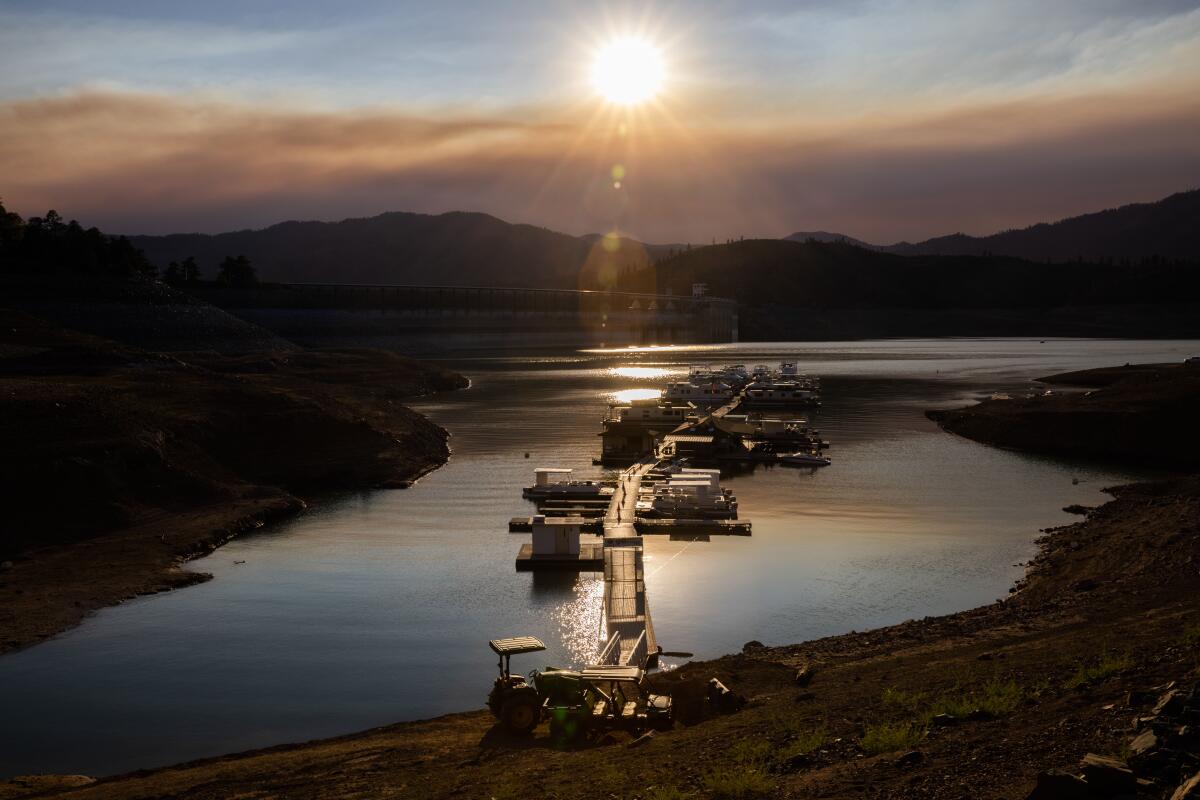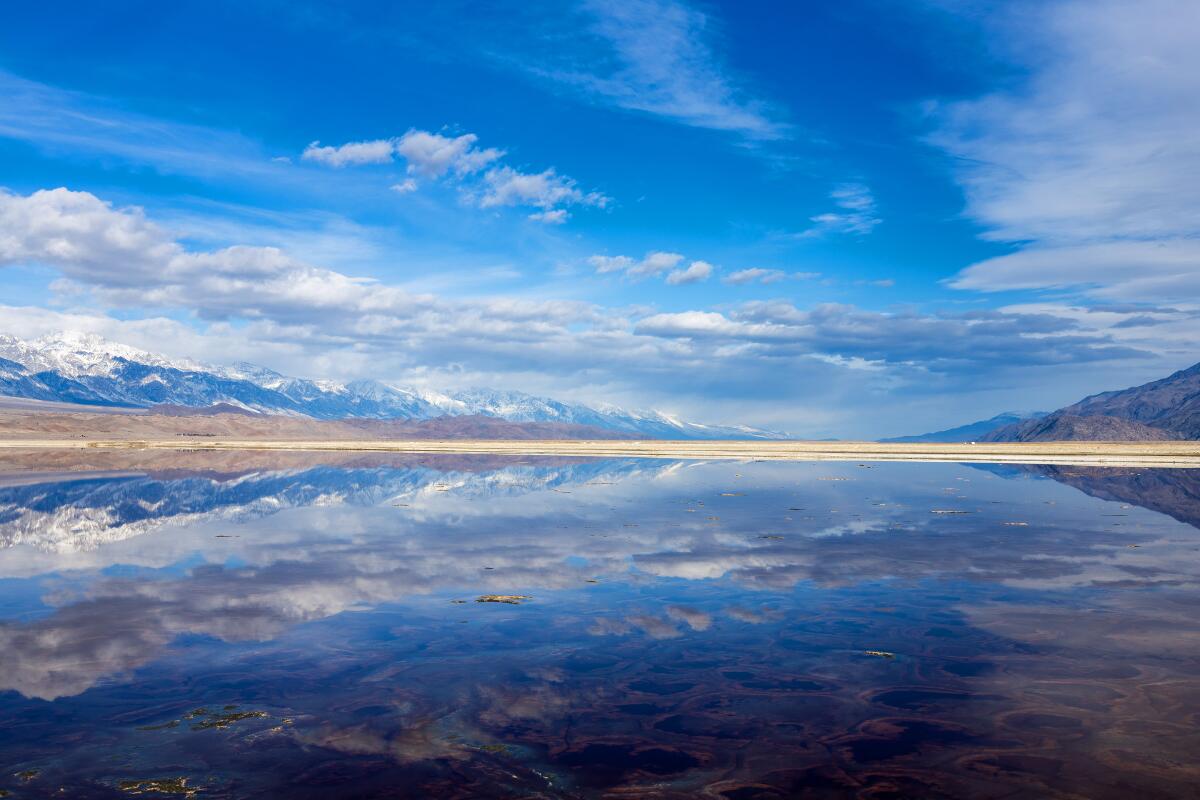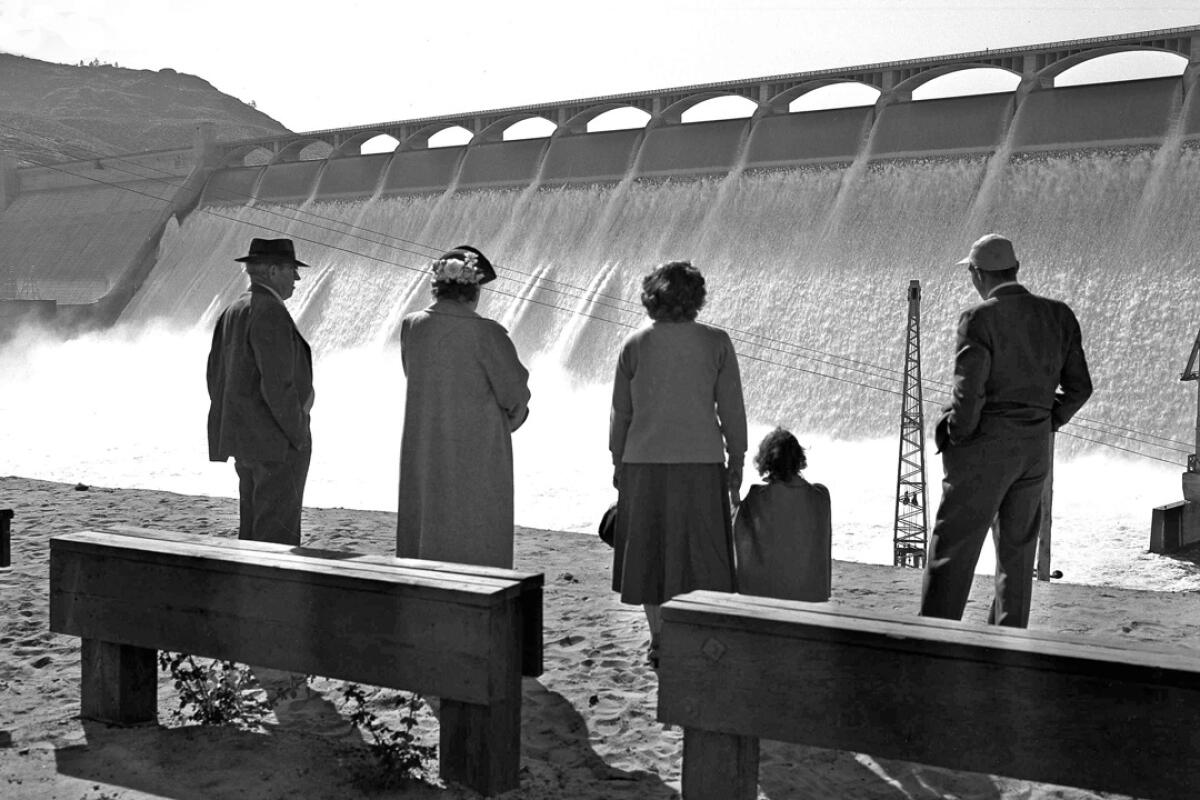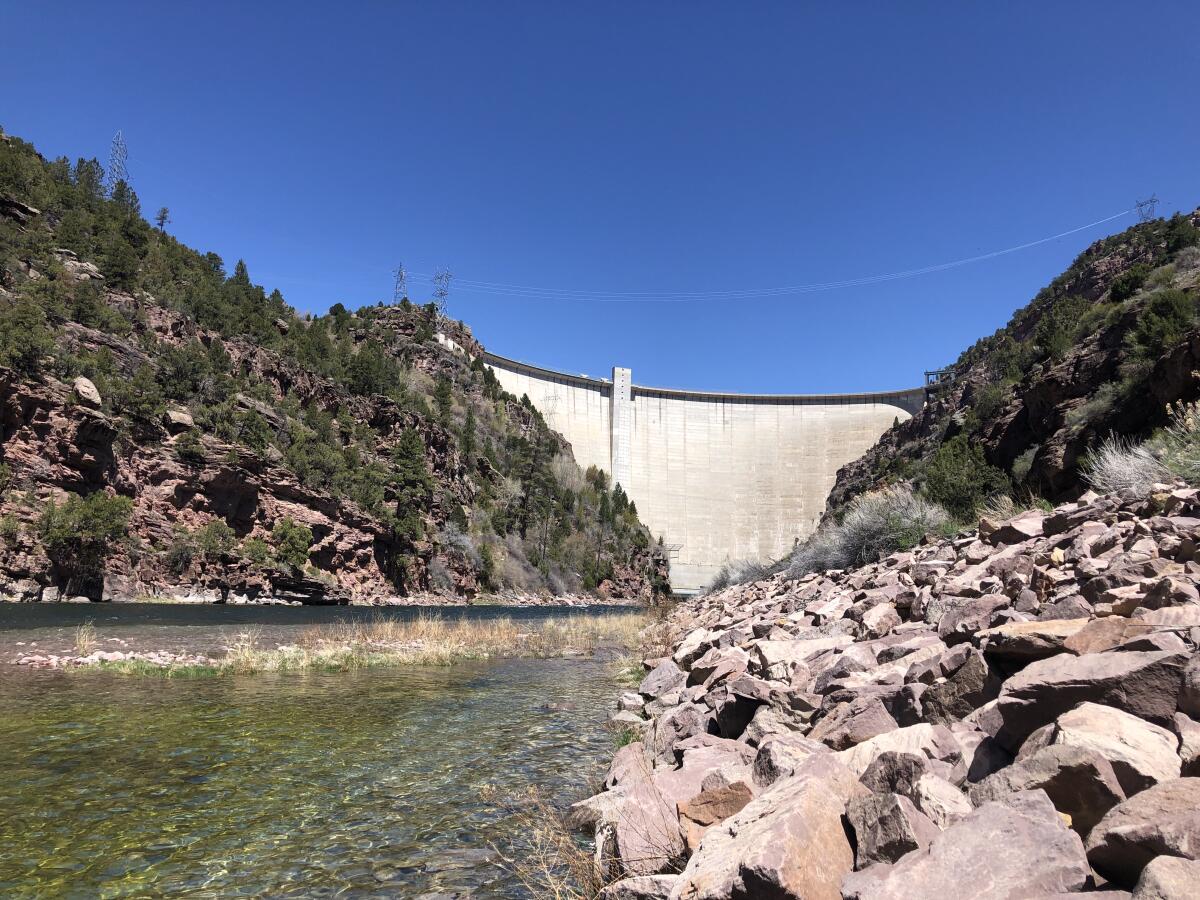Column: Water is life. It’s also energy — whether you like dams or hate them

- Share via
The rain and snow that have drenched California and much of the American West over the last few months — at least relative to some of the hellishly dry years we’ve gotten recently — are a blessing not just for water supplies, but for energy.
Or maybe they’re a curse (for energy, not for water). It depends on whom you ask.
Much of the electricity powering our lights and refrigerators and cellphones comes from rivers, their once free-flowing waters backing up behind dams and trickling through hydropower turbines. The Colorado River, the Columbia, the Sacramento, the San Joaquin — they generate about one-quarter of the region’s power. In the dry years becoming drier with climate change, less water flows through those rivers. As a result, power companies burn more natural gas, a fossil fuel, making climate change even worse.
So it’s a good thing that we’ve gotten relatively more rain and snow this year. Right?
“We shouldn’t have to choose between free-running rivers and clean power,” Kyle Roerink said.
You're reading Boiling Point
Sammy Roth gets you up to speed on climate change, energy and the environment. Sign up to get it in your inbox twice a week.
You may occasionally receive promotional content from the Los Angeles Times.
As I’ve reported previously, hydropower dams definitely aren’t environmental saints. They disturb ecosystems and kill fish, even as the companies operating them try to minimize the deaths. And the reservoirs behind them burp out large amounts of methane, a powerful heat-trapping gas. That doesn’t make dams nearly as bad for the climate as fossil fuels are. But it does mean they’re not as good as solar panels or wind turbines, which are pretty close to zero-emission.
For Roerink — executive director of Great Basin Water Network, an environmental group that works in Nevada and Utah — the solution isn’t to tear down every dam. But he thinks some of the worst offenders need to go, even as others continue to churn out power that’s become increasingly valuable for avoiding blackouts during heat waves and cold snaps.
“We have to adapt as the climate keeps throwing new hurdles in the way of society,” Roerink told me.
This conversation is particularly pressing in late summer and early fall, when rising temperatures are driving up air conditioning use and straining the power grid. So let’s have the conversation now, in March, when it’s not hot and we’re not panicking.
First things first: California had a wet winter.
We’ll have a better sense of the hydropower outlook in a few weeks, when the state Department of Water Resources conducts its much-watched April 1 snow survey (actually scheduled for April 2 this year). But water storage in California’s major reservoirs was at 117% of average on Wednesday, with statewide snowpack at 105% of normal. Those numbers bode well for energy generation at Oroville Dam, Shasta Dam and the state’s other hydroelectric behemoths.

Denis Obiang, a manager at the L.A. Department of Water and Power, told me the agency expects to produce about 500 gigawatt-hours of electricity this year from the Los Angeles Aqueduct, which carries water to the city from the Owens Valley — two and half times what the aqueduct produces during a “normal” year. That’s largely a result of the huge snowfall in the Sierra Nevada.
That should mean less need to fire up four polluting gas plants in the Los Angeles Basin when it gets hot and Angelenos crank up their air conditioners — including one especially controversial gas plant surrounded by a largely Latino, low-income San Fernando Valley community that until 2020 leaked methane gas for at least three years.
“The snowpack and the rainfall are very significant,” Obiang said.
More water, more climate-friendly energy — and less fossil gas. As long as we keep stoppering rivers.
Rain and snow in the Colorado River Basin, meanwhile, have been decent so far this year, but not as good as in California. And even after a wonderfully wet 2023, Lake Mead and Lake Powell — the Colorado’s biggest reservoirs — are still super low. The seven states that depend on water from those reservoirs are still scrambling to strike a deal that will stop them from crashing.
Overall, we shouldn’t expect hydropower production to increase much on the Colorado River this year, according to Eric Kuhn, a retired water manager in Colorado state. Although slightly higher water levels at Mead and Powell should push production up a bit — more water behind Hoover and Glen Canyon dams will mean more pressure on the turbines, resulting in more electricity generation — the dam managers will be doing everything they can to minimize releases and build water levels back up.
That’s an important takeaway for the Golden State, which relies on Hoover Dam not only for water but for energy.
“How much power you can produce at a dam relies on how much water you can release,” Kuhn said.
Indeed, it’s all connected — water, energy, drought, climate, natural gas, heat waves, dams, rivers. Everything.
I’ll get back to those far-out musings in a minute. First, let’s take a jaunt to the Pacific Northwest.
Similar to the Colorado River system, the Columbia River and its tributaries have had not-terrible but not-quite-average rain and snow so far this winter. The snow has been especially below average in the Canadian mountains that typically keep the Columbia flowing strong through the summer, according to Bonneville Power Administration hydrologist Ann McManamon.
“We don’t know whether or not we’re going to get saved by spring rains,” McManamon said.

Before getting into the importance of late-summer hydro specifically, let’s talk about Bonneville. It’s a federal agency that sells electricity from the massive Grand Coulee Dam on the Columbia River, and from dozens of other dams across the watershed. Its leaders know well that weather phenomena of all kinds are getting harder to predict with global warming.
They also know well that having more water behind dams makes it easier to squeeze through tricky weather situations.
That’s true for Oregon and Washington, which draw on their dams to produce electricity to keep warm during cold spells. It’s also true for California, which has gotten into the habit of relying on imports from the Columbia River dams to help keep the lights on when it’s hot here and the sun sets and our solar panels stop producing — a risky bet as the planet heats up, and it’s increasingly likely the entire West is scorching, and maybe a fire takes down the power lines linking California with the Pacific Northwest.
That was a mouthful. Let’s breathe for a second. The climate crisis, it’s a lot. Slow down, collect our thoughts.
OK, home stretch.
Ryan Egerdahl, a power planning manager at Bonneville, told me if water conditions don’t change too much on the Columbia over the next few months — still a big “if” — there should be enough slack on the system to export some electrons to California later in the year, at least for a few hours here or there. That’s good news, from an avoiding blackouts standpoint.
What’s particularly valuable about hydropower, for the folks managing the electric grid, is that it can be there whenever they need it. If you’ve got water behind a dam, all you’ve got to do is open the gates and let water flow through the dam — and voila, you’ve got power. Sun’s going down, but more people are still blasting air conditioning than you expected? Put some water through the dam. Wind not blowing as strong as you anticipated? Put some water through the dam.
Dams aren’t the only technology capable of playing that role without fueling the climate crisis.
A major reason California hasn’t had rolling blackouts since 2020, for instance, is that we’ve added thousands of megawatts of lithium-ion batteries to the electric grid. Geothermal power plants can generate renewable electricity 24/7. And the more we can slash energy consumption — through steps such as buying more efficient appliances and using less water — the better.
“We’re surrounded by opportunities,” Fred Heutte said.
Heutte is a senior policy associate at the NW Energy Coalition, a clean energy advocacy group based in Seattle. The opportunities he’s most focused on involve utilities and power-grid operators doing a better job of sharing resources: finding ways to send solar and wind and hydropower from where they’re available to where they’re needed, and thus limiting the need to spend large sums of money — and waste large numbers of years — building huge new infrastructure projects across the Western U.S.

I’ll have more on the people working to build a coordinated Western electricity market in a future column. Whether or not that work succeeds, though, Heutte believes we need to do a better job of planning for years when hydropower disappoints.
“It’s helpful when it’s there, and we need to be more ready than we have been when it’s not there,” he said.
Hydropower accounted for just under 6% of U.S. electricity last year. In California, it ranged from 5% to 17% over the last decade.
Knowing what we know about the climate crisis — about how much harder it’s getting to keep the lights on as temperatures rise; about how difficult it is to build solar and wind farms; about research finding that rooftop solar won’t be enough to power society — do we really want to start tearing down dams that supply lots of energy and play a crucial role in staving off blackouts?
You’ll have to answer that question for yourself.
But it’s worth putting some thought into it now, in March, when the electric grid isn’t stressed. Then we can revisit it in the fall, after there’s a big heat wave and we’ve all gotten emergency texts begging us to use less power, lest the lights go out.
ONE MORE THING

Nancy Rivera Brooks has worked at the L.A. Times for 42 years. For the last five, I’ve been lucky to call her my editor and friend.
She’s edited on the business desk since 2004, helping countless reporters — I guess we could count them, but who’s got time? — ask better questions, write sharper sentences and tell more meaningful stories. Her guidance has been especially valuable for me personally, as far as I’m concerned, because before becoming an editor she was an energy reporter like me. So when I file stories about the electric grid and utility regulation and community choice aggregation, she knows exactly what I’m trying to say.
This is Nancy’s last week at The Times — she’s retiring. Friday is her last day.
More important than her journalism savvy, Nancy is incredibly humble and kind. She rejected my pitch to dedicate this edition of Boiling Point to an interview with her about her 42 years at The Times. She’ll probably only grudgingly allow this short ode.
Also important: Nancy is, like me, a huge Dodgers fan. So go Shohei, go Kiké, go Clayton. Opening day is less than a week away.
Thank you for everything, Nancy.
This column is the latest edition of Boiling Point, an email newsletter about climate change and the environment in California and the American West. You can sign up for Boiling Point here. And for more climate and environment news, follow @Sammy_Roth on X.
Toward a more sustainable California
Get Boiling Point, our newsletter exploring climate change, energy and the environment, and become part of the conversation — and the solution.
You may occasionally receive promotional content from the Los Angeles Times.




